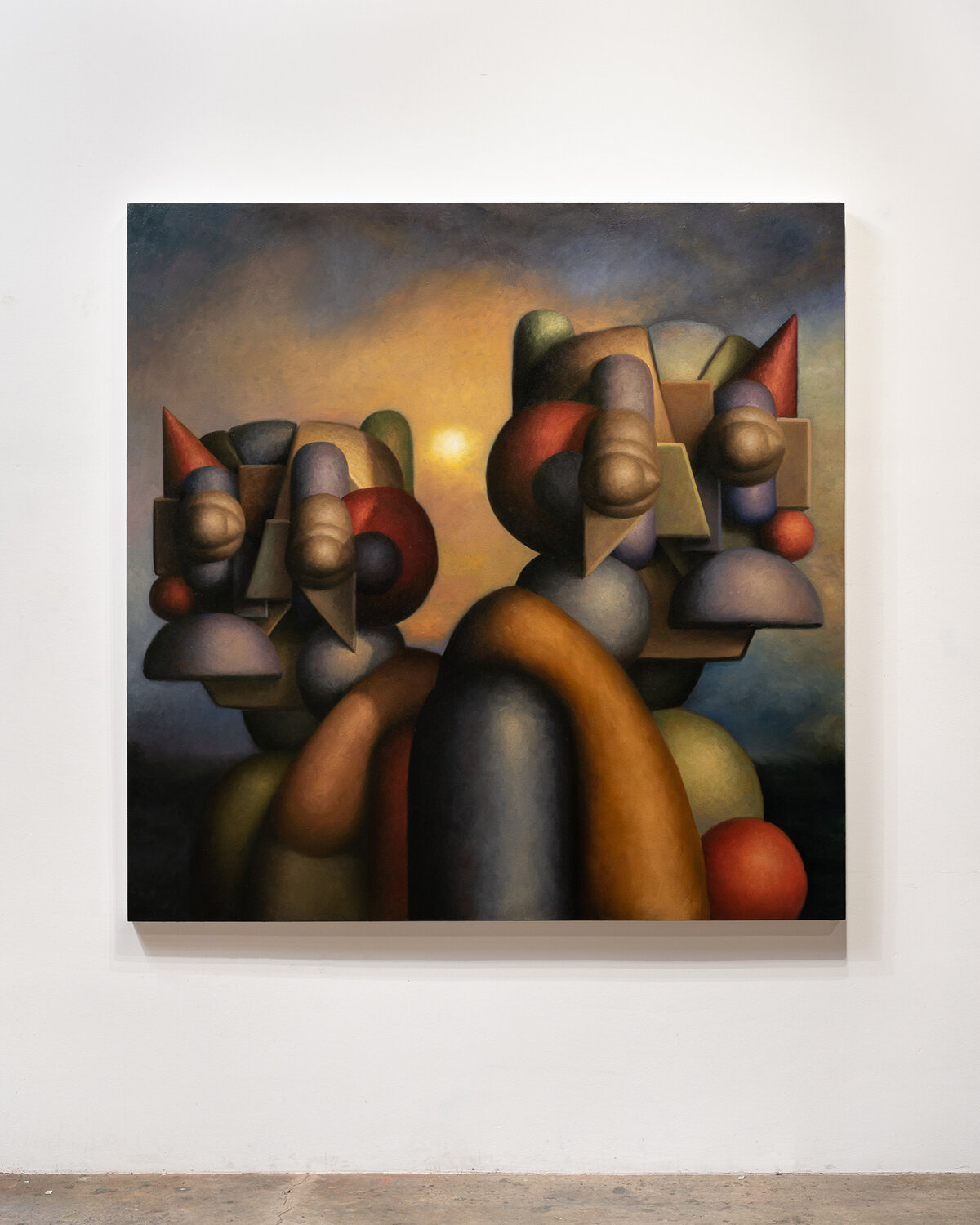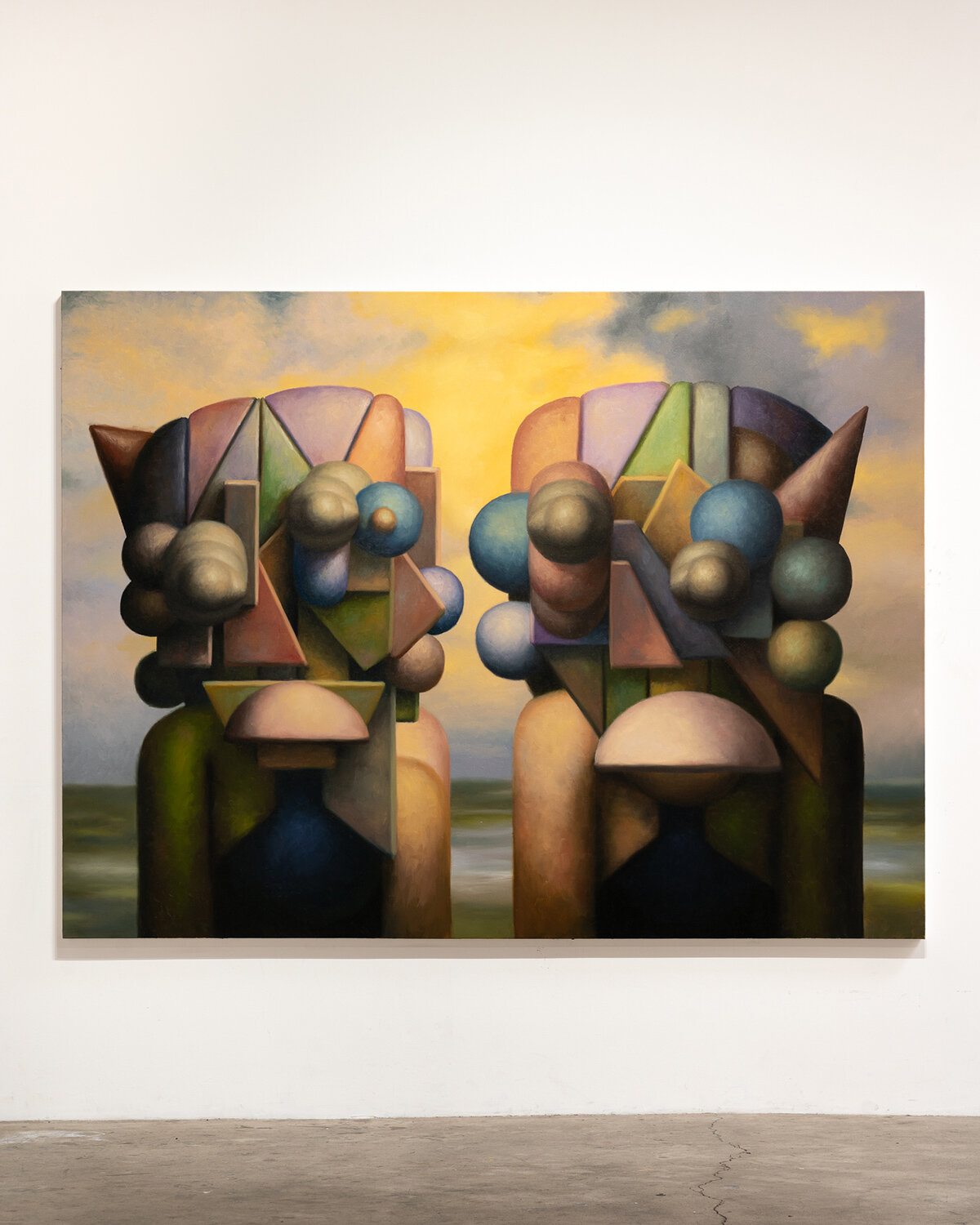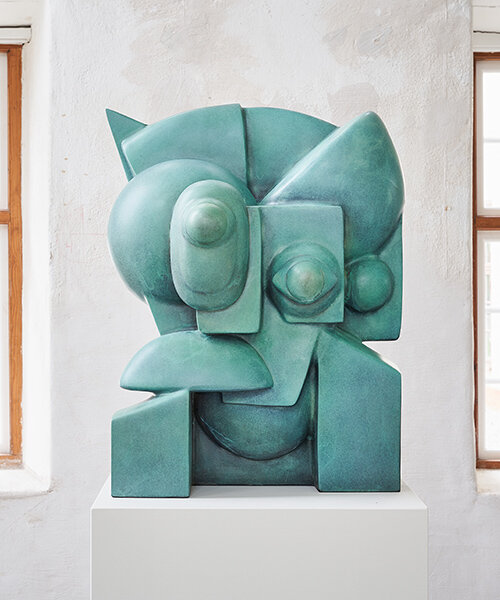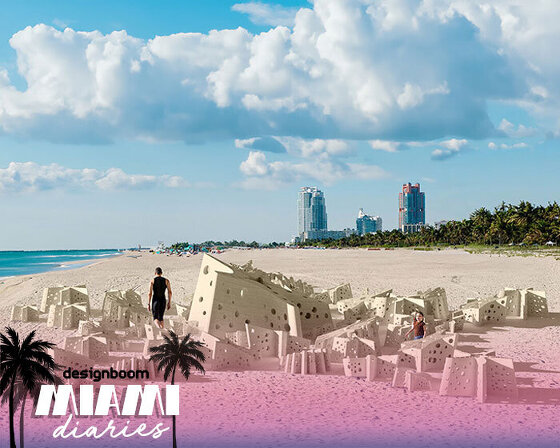pareidolia opens at carl kostyál’s stockholm gallery
Devon DeJardin‘s newest exhibition, Pareidolia, has opened as a showcase of his signature blend of the familiar and the fantastical. The show’s title refers to the psychological phenomenon of pareidolia, where familiar patterns are perceived in random stimuli, such as seeing faces in clouds. This concept is central to DeJardin’s work, where his rendered images of stone-like portraits invite viewers to discover their own meanings and interpretations. His sophisticated use of color and dramatic chiaroscuro lighting creates a sense of solidity and otherworldliness in these forms, evoking at once a sense of comfort and mystery. Pareidolia is on view at Carl Kostyál Gallery in Hospitalet, Stockholm until July 21st, 2024.
In an interview with designboom, the artist discusses the inspirations and processes behind his works shown with Carl Kostyál gallery. He explains how the Guardians, the central figures in his paintings, draw on a tapestry of historical, cultural, and modernist influences. These figures appear as both sculptures and abstract forms, and are intended to symbolize humanity’s quest for protection and understanding through various belief systems. By blending elements of past and future, reality and imagination, the works challenge viewers to reflect on their perceptions of reality, faith, and the power of images.
 Devon DeJardin, Pareidolia, exhibition view | image © Per Englund
Devon DeJardin, Pareidolia, exhibition view | image © Per Englund
a dialogue with Devon DeJardin
designboom (DB): Can you tell us about the inspiration behind the title Pareidolia for your exhibition? How does this concept relate to the works displayed?
Devon DeJardin (DD): The human mind has always possessed a deep desire to ascribe meaning to everything — take constellations, for example. What we call ‘The Big Dipper’ in the United States is ‘The Great Wagon’ in Germany, or in Indonesia, the ‘Boat’ or ‘Canoe Stars.’
This tendency to perceive familiar patterns in random stimuli is known as pareidolia, which serves as the inspiration for the title of this exhibition. This concept connects directly to the works displayed, inviting viewers to find their own meanings and interpretations in the art. They are dynamic, ever-changing, and constantly evolving.

Devon DeJardin, Pareidolia, exhibition view | image © Per Englund
DB: Your paintings feature forms that are at once familiar and otherworldly — how do you achieve this balance, and what do you hope viewers will perceive in these shapes?
DD: I aim to evoke a blend of nostalgia and curiosity, appreciation of the past, and anticipation of the future through my work. By incorporating elements that are both recognizable and abstract, I create a visual dialogue that invites viewers to explore the duality of familiarity and mystery. The concept of Pareidolia serves to reflect the paradoxes of life, with the Guardians acting as stable, comforting figures amidst the ever-changing chaos, encouraging viewers to discover their own interpretations and connections.

Devon DeJardin, Pareidolia, exhibition view | image © Per Englund
DB: The ‘Guardians’ in your work have a modernist feel while drawing on historical and cultural references. Can you elaborate on the significance of these influences and how they manifest in your art?
DD: The Guardians symbolize humanity’s intrinsic need to find comfort and strength in the idea of protection by a higher power. They are a synthesis of various faiths, beliefs, and cultures, representing a mosaic of the human experience. Drawing inspiration from historical and cultural references, these figures transcend specific timelines or ideologies, touching each viewer uniquely. They weave together elements of the past and present, creating a universal narrative that resonates with our collective consciousness, encouraging contemplation and dialogue about our shared and individual journeys.

Devon DeJardin, Pareidolia, exhibition view | image © Per Englund
DB: It was mentioned that Julian Jaynes’ theory of the Bicameral Mind influenced your approach to creating these works. Can you elaborate?
DD: Julian Jaynes’ theory of the Bicameral Mind suggests that ancient humans experienced thoughts as auditory hallucinations, perceived as commands from gods, which later evolved into introspective consciousness. This shift marked the transition from direct divine communication to a more self-reflective human experience. In Pareidolia, I aim to reconnect with this ancient sense of divine presence. These Guardians symbolize a reconnection with an era where divine presence was manifest in the physical world, inviting viewers to engage with a deeper, more intuitive sense of spirituality and guidance

Devon DeJardin, Pareidolia, exhibition view | image © Per Englund
DB: Your use of light is described as Caravaggesque and otherworldly. How do you use lighting to enhance the sculptural quality and emotional impact of your paintings?
DD: In my view, light and darkness are complementary rather than opposing forces; one cannot exist without the other. This delicate balance is essential to human life, fostering resilience and strength. Beyond creating physical depth, the interplay of light and darkness adds emotional depth to my paintings. Light emerges from the shadows of darkness — representing fear, vulnerability, and hardship — highlighting that triumph is born from sacrifice, knowledge from error, and love from loss. This juxtaposition celebrates the complexity of human life.

Devon DeJardin, Guardian Alden, 2024, bronze | image © Per Englund
DB: In creating your Guardians, you blend figure and abstraction. Can you discuss your process in developing these anthropomorphic forms and their geometric compositions?
DB: The Guardians are born from intentionality and a deep exploration of global traditions and beliefs. My process begins with rough sketches that evolve into refined drawings. These are then digitally rendered to create dimension and lifelike details. Once satisfied with the work, I transfer the design back to canvas to complete the painting. The Guardians’ mystical yet familiar appearance is the result of this meticulous process. Geometry aids in creating abstraction, while also grounding the figures in the natural world, merging our reality with the realm of the Guardians.

Devon DeJardin, Those Who Watch, 2024, oil on canvas | image by Ahram Park © the artist, courtesy Carl Kostyál
DB: Your work is said to explore faith in images, representation, and reality. What questions or reflections do you hope to evoke in viewers regarding these themes?
DD: I hope to encourage introspection and challenge viewers to examine their inner turmoils and beliefs through the lens of the Guardians. By exploring faith in images, representation, and reality, I aim to spark dialogue about the nature of belief, the power of symbols, and the ways in which art can serve as a bridge between the seen and unseen, the known and the unknown. I want viewers to question how they perceive reality and consider the role that faith and spirituality play in their lives. What do these Guardians symbolize for them personally? How do these abstract figures challenge or affirm their understanding of protection, guidance, and higher powers? Ultimately, I hope my work fosters a deeper connection to the universal human experience, prompting reflection on the profound and often unseen forces that shape our existence.

Devon DeJardin, Candlelight Confrontation, 2024, oil on canvas | image by Ahram Park © the artist, courtesy Carl Kostyál
DB: As a self-taught artist, how have your unique experiences and perspectives shaped the evolution of your style and technique over the years?
DD: Artists like Picasso, Nevelson, Hepworth, and Tanguy have profoundly transformed modern art and impacted countless artists, including myself. My growth as an artist has been significantly influenced by studying these predecessors and striving to build upon their contributions to contemporary art while also working to introduce new concepts. My background in studying world religions has also deeply informed my work. The exploration of diverse belief systems provided me with a rich tapestry of symbols and narratives to draw from, enabling me to create pieces that aim to resonate with universal themes of spirituality, faith, and the human experience.

Devon DeJardin, Sentinel, 2024, oil on canvas | image by Ahram Park © the artist, courtesy Carl Kostyál
DB: The physicality of your paintings almost suggests that the sculptures they depict exist in reality. How do you navigate the interplay between two-dimensional painting and the illusion of three-dimensional form?
DD: Incorporating technology into my work allows me to blend three-dimensional, sculptural elements with a flat canvas, creating an immersive experience that draws viewers into the Guardians’ world. This fusion of 2D and 3D expands the narrative and scope of my pieces, making the depicted sculptures feel tangible and real, while enhancing the overall storytelling aspect.

Devon DeJardin, Pareidolia, exhibition view | image © Per Englund
DB: Can you discuss the significance of the color palette and chiaroscuro in your work? How do these elements contribute to the narrative and emotional resonance of your paintings?
DD: The color palette in Pareidolia is meant to convey the timeless wisdom of the Guardians. Warm, rustic tones create a sense of a welcoming embrace, inviting viewers into their world. Chiaroscuro, the dramatic interplay of light and dark, not only adds depth and dimension but also enhances the emotional resonance of the paintings. This technique helps to underscore the narratives within the work, highlighting the tension and harmony between light and darkness, and ultimately reflecting the intricate complexities of human experience.








project info:
exhibition title: Pareidolia
artist: Devon DeJardin | @devondejardin
gallery: gallery | @carl.kostyal
location: Hospitalet, Sjökvarnsbacken 15, 131 71 Nacka, Stockholm, Sweden
on view: June 12th — July 21st, 2024
photography: © Per Englund, Ahram Park














